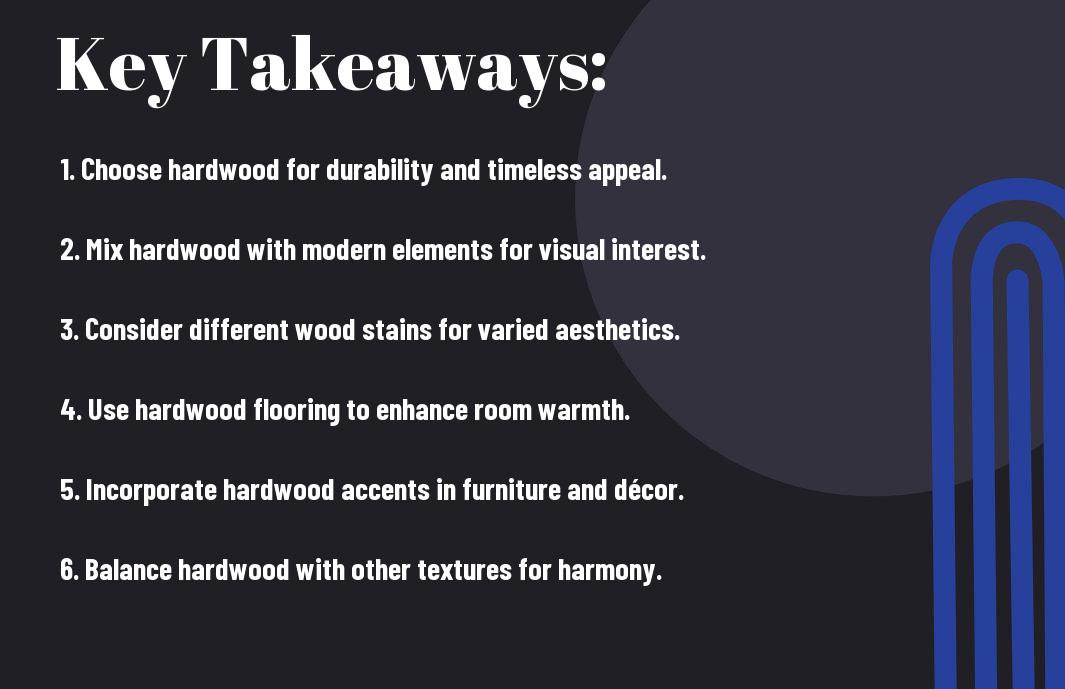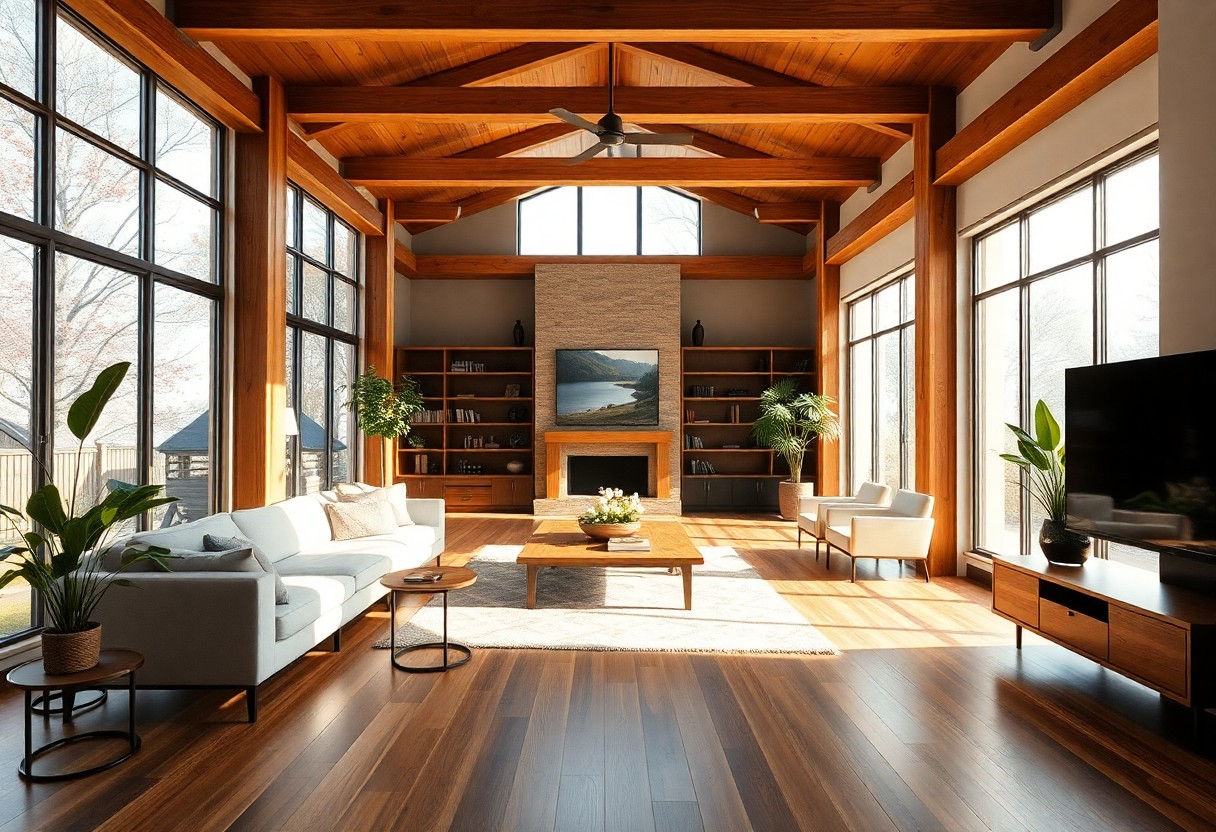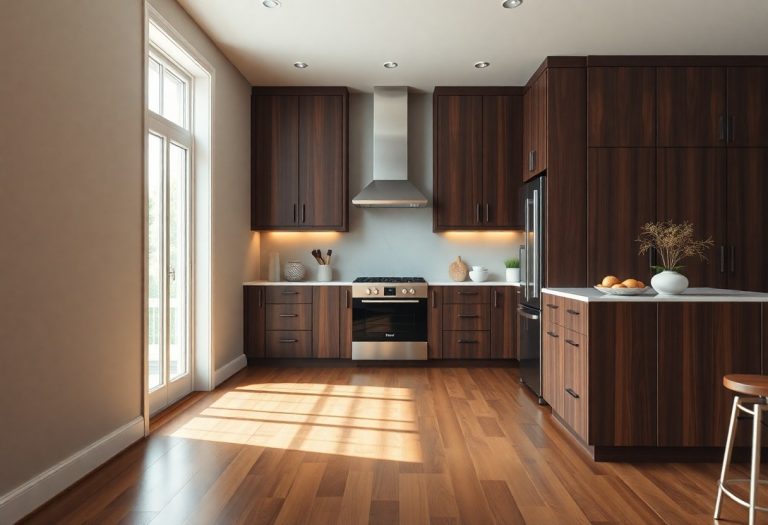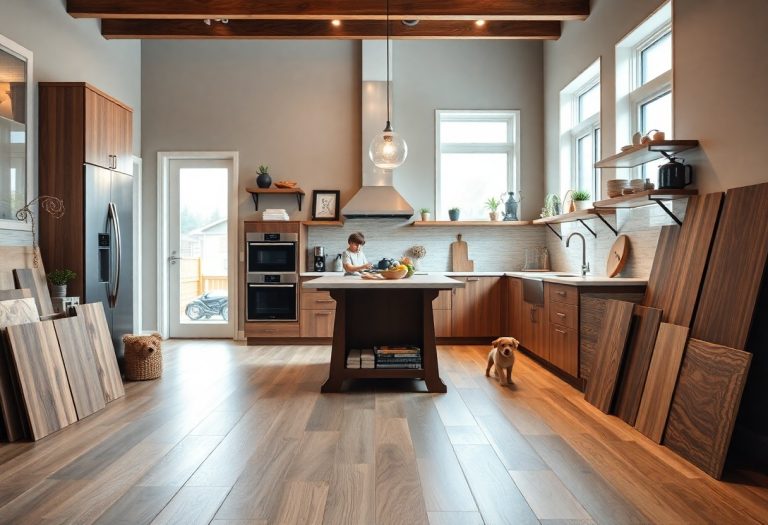Renovation projects provide you with the perfect opportunity to enhance your home’s aesthetic, and one of the most impactful ways to achieve this is by incorporating hardwood giants into your design. These stunning materials not only exude elegance and warmth but also bring durability and timelessness to your space. In this post, you will discover how to seamlessly integrate large hardwood elements into your DIY renovations, transforming your home into a stylish sanctuary that reflects your personal taste while maintaining functionality.


Understanding Hardwood Giants
To fully appreciate how hardwoods can enhance your home renovation project, it’s necessary to understand the concept of “Hardwood Giants.” These are typically large trees known for their durable and aesthetically pleasing timber. Incorporating these materials into your design can provide a sense of grandeur and permanence, enhancing not only the aesthetic appeal of your spaces but also the overall value of your home. By selecting the right hardwood, you can lend an air of sophistication and refinement to any room, be it through flooring, cabinetry, or decorative accents.
Benefits of Using Hardwood
Hardwood offers a range of advantages that make it an ideal material for various renovation projects. Firstly, its durability is unmatched, allowing it to withstand the wear and tear of daily life while maintaining its beauty for years. Additionally, hardwood can improve indoor air quality by minimizing allergens compared to carpets and synthetic materials, making it a healthier choice for your home. Beyond practicality, hardwood has a timeless elegance that can elevate your design aesthetic, providing an invaluable return on investment.
Popular Types of Hardwood
Types of hardwood vary widely, each bringing its unique characteristics and appeal to your home decor. When opting for a hardwood, consider options such as Oak, Maple, Cherry, Walnut, and Hickory. Here’s a quick overview of these popular hardwoods:
| Type | Characteristics |
|---|---|
| Oak | Strong, durable, and comes in red and white varieties. |
| Maple | Light-colored, fine grain, and very durable. |
| Cherry | Rich color that deepens with age, offers a warm aesthetic. |
| Walnut | Dark, luxurious look with rich patterns and textures. |
| Hickory | Dense, heavy wood with striking color variation. |
Popular hardwoods can dramatically impact the visual tone of your renovation efforts. Not only do different types offer varying levels of durability and grain patterns, but they also come with distinct colors that can range from light to deep hues. Understanding these distinctions allows you to choose the perfect hardwood that complements your desired style and functionality.
- Each type resonates with unique qualities, enhancing your design scope.
- Understanding grain patterns can elevate your aesthetic choices.
- Color variation adds richness and warmth to your space.
- Durability of hardwoods ensures longevity in your renovation.
- Thou shalt experience the transformative power of well-chosen woods.
Planning Your Renovation
The first step when planning your renovation is to establish a clear vision of how you want to incorporate hardwood flooring into your home. Consider not only the aesthetic appeal of the hardwood giants, but also how they will complement your existing decor and furniture. Take a moment to envision the overall theme you’re aiming for, whether it be rustic, modern, or a blend of styles. This vision will guide you as you make important decisions about colors, finishes, and design elements throughout the renovation process.
Assessing Your Space
Planning your renovation begins with assessing your space to understand its unique characteristics and limitations. Take accurate measurements of the rooms you wish to renovate, and make note of any irregularities such as doorways, windows, and structural elements that may influence your hardwood design. By recognizing these factors, you can better decide on the types of hardwood and installation patterns that will work best for both aesthetics and functionality in your space.
Budgeting for Hardwood Installation
Planning your budget for hardwood installation is important to ensure your renovation can be completed without financial stress. Begin by researching the costs of different hardwood options, including species, finish types, and whether you’ll handle the installation yourself or hire a professional. Factor in additional expenses such as underlayment, trim, and any necessary repairs that may be revealed once you start removal of existing flooring. This understanding will help you create a realistic budget that aligns with your vision.
Indeed, budgeting for hardwood installation goes beyond just material costs; you should also consider the long-term value that hardwood adds to your home. High-quality hardwood can increase your property’s market value, making it a worthwhile investment. Be sure to allocate some funds for unforeseen expenses, as renovations often uncover hidden issues that could impact your project. Having a flexible budget can help you stay on track without compromising the quality or integrity of your renovation project.
Design Considerations
After deciding to incorporate hardwood giants into your home renovation, you must think carefully about various design considerations that will enhance your living space. The scale and nature of hardwood flooring can dramatically influence your design aesthetic. Consider the layout of your rooms and how the wood will interact with lighting, furniture, and other features. Think about the flow of your home—will the hardwood create a consistent look throughout different areas, or will you opt for varying styles that highlight particular spaces? Your decisions here will play a significant role in creating a cohesive and inviting atmosphere.
Integrating with Existing Decor
Around your home, existing decor elements should be embraced when selecting hardwood. Whether you have a modern or traditional theme, the right wood can complement your furniture and color palette seamlessly. You should take note of furniture styles, textiles, and artwork that you cherish. For instance, if you have rustic pieces, a distressed hardwood finish can highlight those features beautifully, while a sleek, polished wood can enhance a minimalist décor. By integrating hardwood into your existing aesthetic, you’ll create a harmonious environment that reflects your personal style.
Color and Finish Options
Existing colors in your interior are an important consideration when choosing the type of hardwood and its finish. The wood’s color range can vary significantly, from light oak to rich mahogany, and each option will impart a different mood and character to your space. Darker woods can lend warmth and sophistication, while lighter finishes can make your rooms appear more spacious and airy. Consider how different wood tones will interact with your existing palette; warm woods can bring out the undertones in your furnishings, while cooler tones can create a striking contrast.
Considerations should also extend to the finish of the hardwood you select. A matte finish can create a relaxed and casual feel, while a glossy finish can add elegance and a touch of modernity. Depending on the level of foot traffic in your home, you might also want to think about durability and maintenance needs. For high-traffic areas, finishes that resist scratching and staining may be more suitable. Ultimately, the choice of color and finish should enhance your design vision while addressing practical requirements of daily use.
Installation Techniques
DIY Installation vs. Professional Help
Techniques for installing hardwood giants can vary significantly, depending on whether you choose to tackle the project yourself or enlist professional help. If you’re a hands-on homeowner with some experience in renovation, a DIY approach can save you money and provide a fulfilling sense of accomplishment. You’ll have the opportunity to personalize your installation process, ensuring that every plank aligns with your design vision. However, it’s important to assess your skill level honestly; if this is your first flooring project, you may encounter unforeseen challenges that could lead to frustration or subpar installation.
On the other hand, opting for professionals can alleviate stress, especially if you have a larger space or complex designs in mind. Experienced installers bring a wealth of knowledge, ensuring that your hardwood giants are laid optimally for both aesthetics and durability. Often, they are equipped with specialized tools and techniques that can expedite the process and produce a higher-quality finish. Weigh your options carefully to decide what aligns best with your goals and comfort level.
Tools and Materials Needed
Above all, having the right tools and materials is important for a successful hardwood installation. Start with high-quality flooring boards, an underlayment if necessary, and adhesives or nails based on your chosen installation method. Basic tools will include a miter saw for cutting, a nail gun for fastening, and a tapping block to ensure your boards fit snugly without damage. Don’t forget safety gear, such as goggles and ear protection, to safeguard yourself during the project.
Installation requires careful planning regarding the materials you’ll utilize, but with the right tools at hand, you can transform your space effectively. Take time to research the specific types of hardwood flooring available to you, as well as the corresponding underlayments, adhesives, or fasteners that suit your needs. By preparing yourself with a comprehensive list of necessary equipment, you’ll streamline the process and enhance the overall quality of your installation, ensuring your beautiful hardwood giants are showcased to their fullest potential.
Maintenance and Care
Once again, maintaining the beauty and integrity of your hardwood giants is crucial for preserving their charm in your home. Regular upkeep not only enhances their aesthetic appeal but also extends their lifespan, ensuring you enjoy their elegance for years to come. Being proactive in your maintenance routine will help you avoid costly repairs in the future while keeping your hardwood flooring or furniture in top shape.
Cleaning and Upkeep
Behind every stunning hardwood feature lies a well-planned cleaning regimen that helps maintain its glossy finish. To keep your hardwood surfaces looking their best, you should aim for a cleaning schedule that includes frequent dusting and sweeping to prevent dirt and debris from scratching the wood. Using a microfiber mop and a pH-balanced cleaner specifically designed for hardwood can help you remove stubborn stains without damaging the natural finish.
Repairing Damages
Against the natural wear and tear that comes with time, your hardwood surfaces may develop scratches, dents, or other imperfections. Don’t panic—most minor damages can be repaired easily with the right tools and products. For scratches, you can use a wood filler that matches your hardwood’s color and sand it down once dry. For deeper dents, consider applying a damp cloth and using a steam iron to help lift the wood fibers back into place.
Also, if you find that your hardwood has suffered from more extensive damage, such as large gouges or water stains, you might need to refinish the affected area. This typically involves sanding down the surface and applying protective finishes to restore its original beauty. By taking these simple steps, you ensure that your hardwood giants remain a striking centerpiece of your home for years to come.
Case Studies and Inspiration
Unlike traditional approaches to home renovation, incorporating hardwood elements can elevate your design aesthetic to new heights. By exploring various case studies, you can gain valuable insights into how to successfully integrate hardwood giants into your spaces. Consider the following examples which highlight remarkable transformations and the benefits of hardwood in contemporary design:
- The Modern Loft: A 1,500 sq ft urban loft renovated in 2022 featured reclaimed oak flooring, enhancing warmth while keeping a modern edge. The project increased property value by 15%.
- The Rustic Retreat: A 2,000 sq ft cabin renovation in the mountains used hand-scraped hickory for walls and ceilings. The design successfully appealed to nature enthusiasts, with a resulting 30% increase in rental rates.
- Mid-Century Modern Revival: A 1,800 sq ft home underwent a revitalization with walnut cabinetry and engineered hardwood floors. This renovation not only updated its aesthetic but also led to a 20% decrease in energy costs due to improved insulation properties.
Successful Hardwood Renovation Projects
Hardwood elements have proven to be effective in upgrading homes and enhancing design. A staggering 73% of homeowners who included hardwood in their renovations reported an increase in both aesthetics and comfort, according to a recent survey. One notable success story includes a family home where the installation of bamboo floors created an eco-friendly atmosphere, contributing to a significant 25% reduction in allergens and improved air quality.
Trends in Hardwood Design
To stay ahead in the home design game, it’s necessary to be aware of current trends that utilize hardwood in innovative ways. Light, neutral shades of hardwood are gaining popularity as they create a sense of spaciousness in both small and large areas. Additionally, mixed materials that pair hardwood with metals and glass are trending, providing a contemporary flair while maintaining classic wooden warmth.
Further, the use of sustainable and reclaimed hardwood has become increasingly important as many homeowners prioritize eco-friendliness in their renovation projects. Opting for materials that are not only striking but also environmentally conscious will ensure that you are in line with today’s design ethos. By embracing these trends, you can create a space that is not only visually stunning but also speaks to your commitment to sustainability and contemporary style.
Summing up
The integration of hardwood giants into your DIY home renovation project can elevate your design aesthetic while providing a lasting, high-quality appeal. By selecting the right types of hardwood and employing techniques that enhance their natural beauty, you can create stunning visual focal points that embody both elegance and warmth. Your approach to layout, finishes, and complementary materials can ensure that the hardwood elements harmonize seamlessly with your overall design vision.
Ultimately, the decision to incorporate hardwood giants into your space offers numerous advantages beyond aesthetic appeal, including durability and ease of maintenance. Embracing this opportunity allows you to customize your home in ways that not only reflect your personality but also add long-term value to your investment. As you initiate on this renovation journey, let your creativity shine through and transform your living environment into a beautiful sanctuary that tells your unique story.





